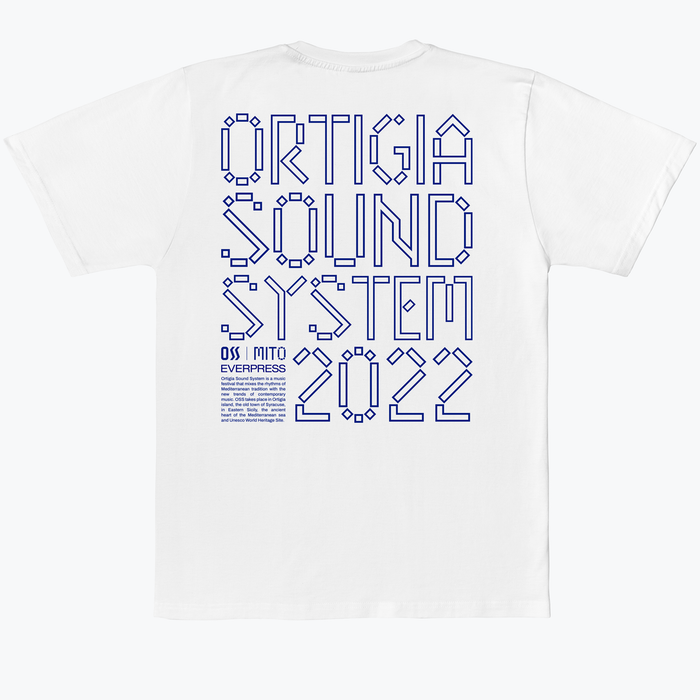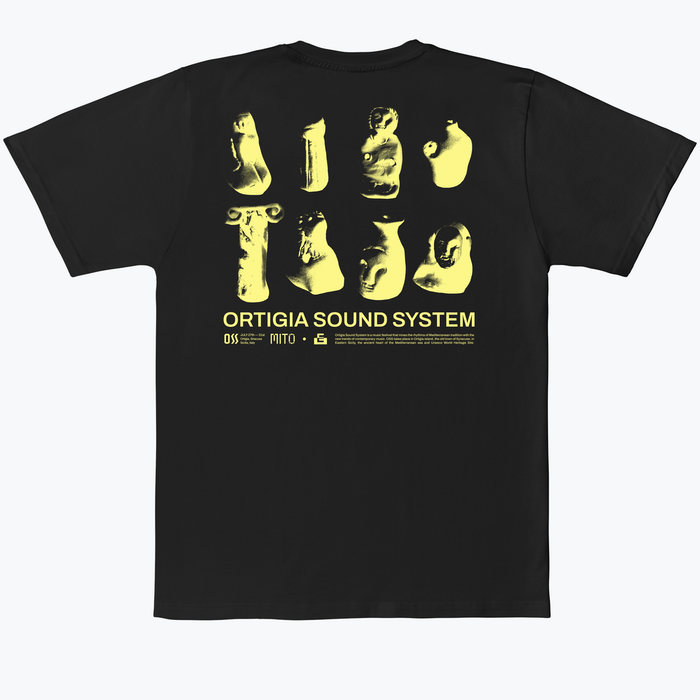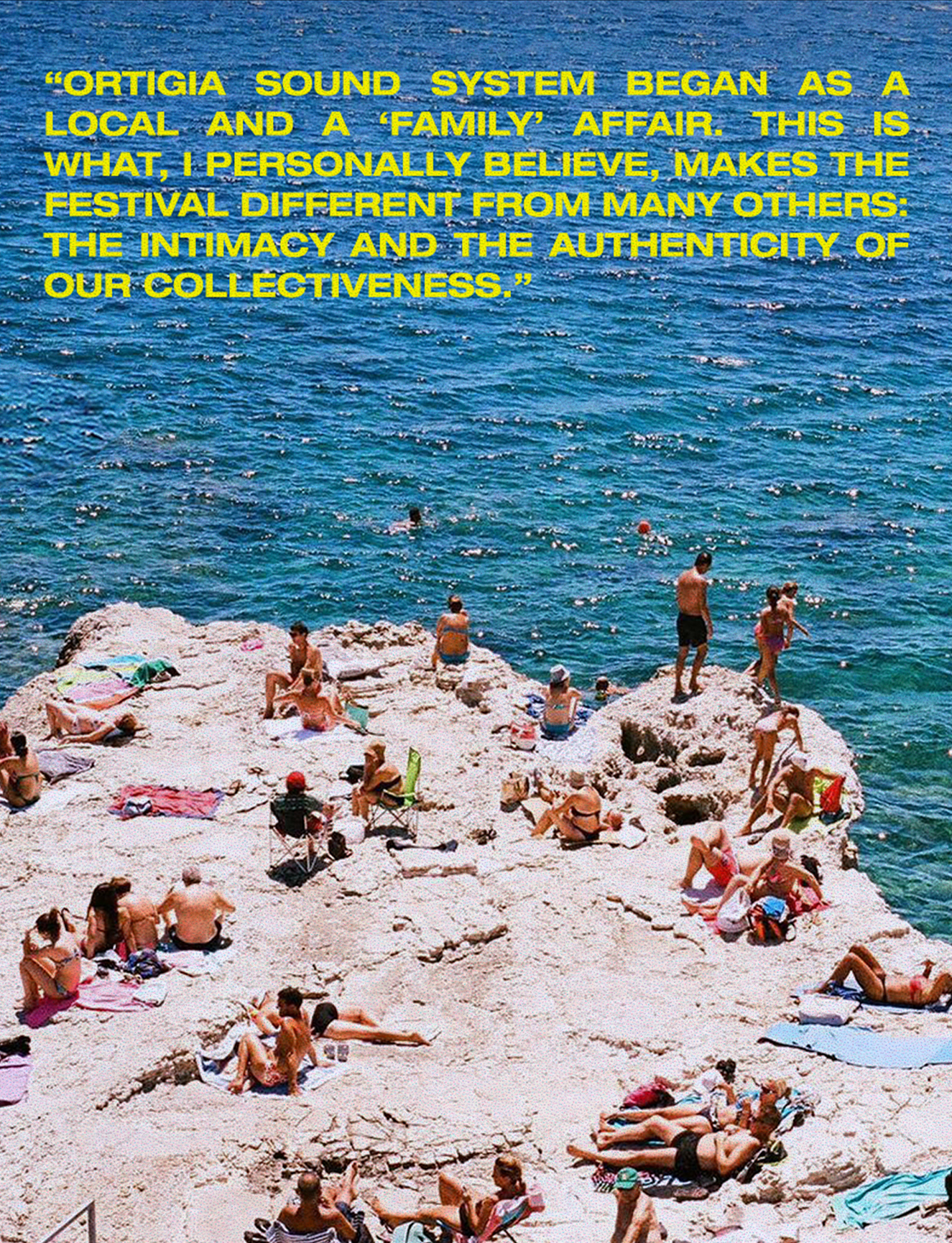OSS is now in its eighth iteration. Can you talk a little bit about how the festival got started? What made you want to run your own festival, and what was it like in the early days?
OSS was born during my Bachelor degree years at the University of Architecture in Syracuse. The idea was purely accidental: a few uni mates (Benedetto “Betto” D’Antoni and I) brought together by a shared passion for festivals and events happening around the island. We started to realise that our parties were growing, and attracting people from all over Sicily, and that was really how OSS came into being.
Here’s a fun fact. While we now have a dedicated hospitality team, the first few years of the festival we used our old student house as a restaurant and accommodation for guests, artists and our staff. Talking about a growing family!
We started to realise that our parties were growing

And how has OSS grown and changed since its inception? What’s stayed the same?
The festival has definitely changed in its professionalism; trying to refine working practices while growing in its artistic, logistics, and communication departments. What has remained of the old Ortigia Sound System is the same spirit that unites the festival with its community, which over the years has grown and spread more and more across Europe. The core evolves, but the authentic bond remains.
How do you preserve that bond?
OSS began as a local and a ‘family’ affair, in large part because local people were always involved in the creation of the festival. This is what, I personally believe, makes the festival different from many others: the intimacy and the authenticity of our collectiveness. Even the environment of the festival makes it more intimate, shortening distances between ‘music spaces’ and tangible relationships.
The core evolves, but the authentic bond remains
On your site OSS is described as a festival that “mixes the rhythms of Mediterranean tradition with the new trends of contemporary music.” Can you talk a little bit about the music scene in Italy more broadly? How does OSS sit within it, and do you think you’re helping to shape a scene there?
OSS has always supported the ever-changing Italian music scene. It’s a scene that has sometimes been fragile, but despite this I believe that in Italy many promising, interesting scenes and audiences have been developing. OSS has been lucky to be able to support and nurture many artists who have grown with the festival itself, like Giampaolo Scampigliati (Lamusa II), Paquita Gordon or even the Italian and Berlin-based label Slow Motion. Artists who still to this day can be found on the line-up of the eighth edition of the festival.
There are also different support systems for artists, such as the artist residency projects that we activated last year. The residencies are such a special project for us, as it’s a set and specific time for each artist to develop connections between different generations and genres of music. It’s a time to experiment with new ideas in the artistic and cultural spheres. I think this is one of the most powerful tools for supporting and funding local cultural scenes.

OSS has always supported the ever-changing Italian music scene
Line-ups might be the one of the most important things about any festival. And OSS has developed a strong reputation for its esoteric programming. What’s important when it comes to curating a lineup, and what do you look for in your artists?
We care a lot about finding ‘the perfect line-up’. We start off by curating the line-up with my booking collaborators in September, right after the previous edition of the festival. It’s a process that takes many months of listening, researching and looking for the right acts. We always try to draw on the Mediterranean avant-guard scene, which I think is one of the biggest values of the festival. At the same time, we try to lean on contemporary music, never setting boundaries and creating a fluid process by using our local reality and venues as a main reference.
What we look for in regards to a successful booking, besides purely the quality of the music, is also the artist’s ‘persona’, the way an artist communicates their work and their values. Communications and visuals are such an interesting and inspiring aspect of our work, so we tend to always keep an eye out on artists who use different means to express their talents.
Capital cities can often act as cultural black holes, where everything culturally significant happens, sometimes at the expense of more regional places. I know Ortigia has a big tourist economy, but what do you think the importance is of having a festival like this, that’s embedded in the local community but is a big cultural moment, drawing people from internationally?
Ortigia is such a precious little island, from its architecture to its history and culture. Ortigia, and also the whole Arethusian territory, is the setting of some of the festival’s most cherished locations such as Lido OSS and the iconic boat parties, up to the hinterland of the countryside, home of the beloved festival afterparties.
The festival has produced, through the support of different design studios, some of the most innovative and interactive venues and stages. We would also like to mention the project that we are going to realise with the support of Red Bull Organics and the designs of the Milanese studio Fosbury Architecture of the Km0 stage, called Kubo.
Kubo is a cage of light, completely covered in a reflective, black cloth during the night hours, will progressively unveil the stage from sunrise onwards
We care a lot about finding ‘the perfect line-up’.
OSS has really distinctive branding and visuals. How important do you think the visuals have been in carving out an identity for the festival?
Each year the festival develops a manifesto that seeks to highlight some of the key features of Sicilian culture, and re-interpret them through a contemporary lens. For example, in 2018, the theme was the Jewish feast of San Fratello (a religious festival of the Easter period). This year, the festival’s graphic persona of the ‘MITO’ is based on a new narrative in which Ortigia Sound System retraces the places of the classical myth. The sculptures of the Palermitan artist Elisabetta Marino were used in order to achieve a contemporary feel, while creating a strong and impactful visual identity.

This year your theme is about “facing a post-pandemic era.” How do you feel the pandemic has affected festivals, especially smaller, specialist festivals? Has it made the need to come together more acute?
Last year’s theme was “Ritornerai”, a manifesto invoking a return to a new normality. Today, after more than one year, we find ourselves in a post-pandemic situation in which the festival returns to its original form. We’re envisioning an eighth edition that’s full of emotions and unique moments after these difficult past few years. To find oneself in the corners of Ortigia without any restrictions is the true essence of Ortigia Sound System festival.
A bridge between innovation and tradition in Sicily
What have been some of your defining moments over the past eight years?
One of the most significant moments was the boat party show by Erlend Øye, a unique performance that brought OSS to a more international sphere, while distinguishing it from other music festivals thanks to its strong setting.
Another moment I am very emotionally attached to is the first after show in the Km0 garden space. During the performance of Avalon Emerson, we caught a glimpse of the sun rising behind the typical Sicilian white dry stone wall. From that moment on, the KM0 sunrise became one of the most significant highlights of the entire festival.
Lastly, is the fanfare performance of the Jews of San Fratello who performed a tour of Ortigia. This moment helped distinguish our festival as a bridge between innovation and tradition in Sicily.
Read More: Ten Years of Principe.



